





What to Do When I Want to Shout – Free Social Story for Self-Regulation
FREE
₹160
100% off
0 (0 ratings)
Grade Levels
Pre-K - Grade 3 (Ages 4-9)
Content Overview
Format: Free Printable PDF, Total Pages: 11, Features: 16 real-life scenarios, engaging illustrations, 6 interactive activities
Categories
Pages from the Resource
This free printable social story teaches children self-control and volume regulation when they feel the urge to shout. Using real-life examples and interactive activities, kids learn how to express themselves calmly and appropriately. Ideal for kids with autism, ADHD, and impulse control challenges.

Page 1

Page 2
What Users Say
0
0 ratings
5
0+
4
0+
3
0+
2
0+
1
0+
5 Stars
Product is Good to use.
10 months ago
Varsha Parent
Similar Products
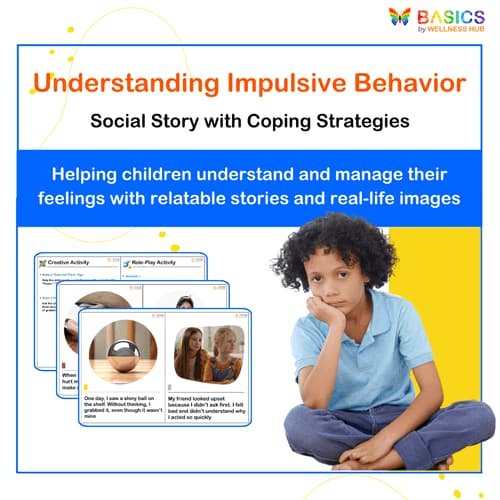
Understanding Impulsive Behavior: Social Story with Coping Strategies
₹ 80.00
₹ 160.00
50% off
4.9 (42 ratings)
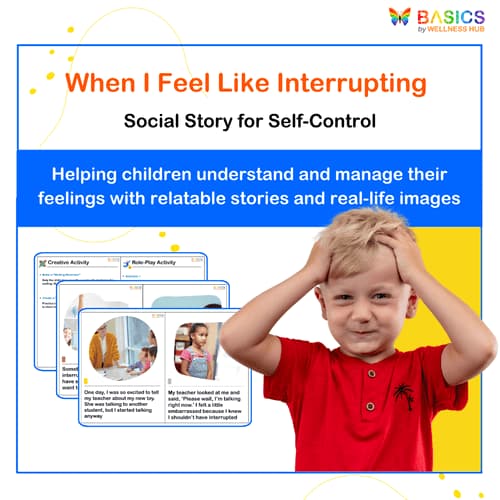
When I Feel Like Interrupting – Social Story for Self-Control
₹ 80.00
₹ 160.00
50% off
4.8 (60 ratings)
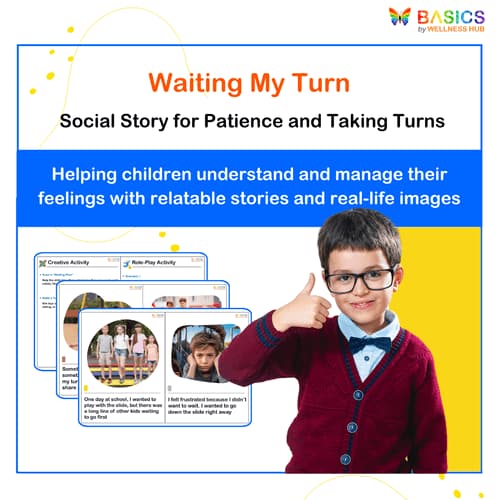
Waiting My Turn – Social Story for Patience and Taking Turns
₹ 80.00
₹ 160.00
50% off
4.7 (56 ratings)
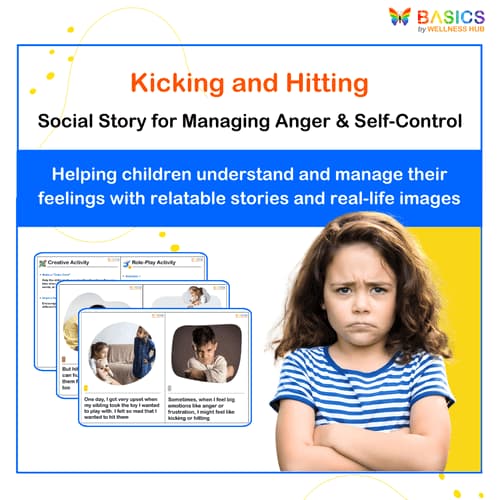
Kicking and Hitting – Social Story for Managing Anger & Self-Control
₹ 80.00
₹ 160.00
50% off
4.6 (52 ratings)
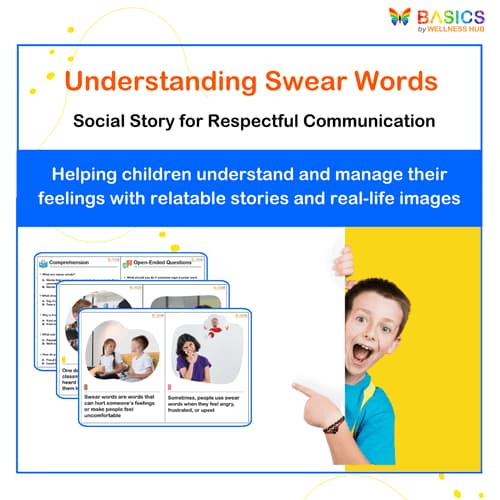
Understanding Swear Words – Social Story for Respectful Communication
₹ 80.00
₹ 160.00
50% off
4.9 (48 ratings)
About the Product
Many young children struggle with impulse control and volume regulation, leading them to shout when they feel excited, frustrated, or overwhelmed. This can be particularly challenging for children with autism, ADHD, sensory processing difficulties, or language delays, who may have difficulty recognizing appropriate voice levels in different situations.
This free printable social story is designed to help children:
✔ Understand why they feel the urge to shout in various situations.
✔ Learn when and where it’s okay to use loud voices and when to use quiet voices.
✔ Discover self-regulation strategies to manage emotions and express themselves appropriately.
Using first-person storytelling, engaging illustrations, and interactive activities, this resource reinforces positive behavior and self-regulation techniques. It is perfect for:
✔ Preschoolers and early learners developing self-control and social skills.
✔ Children with autism, ADHD, or sensory processing challenges who need clear, structured guidance.
✔ Parents, teachers, and therapists looking for an effective tool to help children develop volume awareness and manage impulse control.
By reinforcing positive communication and self-awareness, this social story empowers children to use their voices in a thoughtful and appropriate way.
Product Details
- Format: Free Printable PDF
- Total Pages: 11
- Segments: 16 real-life scenarios teaching volume control and self-regulation.
- Features:
✔ Engaging illustrations to support understanding.
✔ First-person storytelling to help children relate to the lesson.
✔ 6 interactive activities that reinforce self-regulation skills.
✔ Simple, child-friendly language for easy comprehension.
✔ Scenarios include: managing excitement, frustration, asking for help, and using an "inside voice."
This structured social story is an essential tool for teaching volume control, self-awareness, and emotional regulation in young children.
Educational Benefits
This free social story provides a structured and engaging way to teach children when and how to regulate their voice levels.
1. Teaches Self-Awareness & Voice Control
✔ Helps children recognize situations where they feel the urge to shout.
✔ Provides clear explanations of when and where loud voices are appropriate.
2. Encourages Self-Regulation Strategies
Instead of shouting, children are encouraged to:
✔ Take deep breaths.
✔ Use a "quiet voice" cue in calm spaces.
✔ Use a "medium voice" for normal conversations.
✔ Use gestures or ask politely instead of shouting.
3. Supports Social-Emotional Learning (SEL) & Special Needs
✔ Designed for children with autism, ADHD, and sensory processing challenges.
✔ Uses clear, structured lessons to make concepts easy to understand.
4. Reinforces Learning with Interactive Activities
✔ Helps children practice and apply voice control techniques.
✔ Includes hands-on learning opportunities through discussions, role-playing, and drawing activities.
This step-by-step approach ensures that children internalize and apply these self-regulation strategies, leading to better communication and social interactions.
Instructions for Use
This social story should be used consistently to help children develop better self-control and volume awareness.
1. Read & Discuss the Story
- Read the story aloud with your child or student.
- Pause at key moments to ask reflection questions:
"Why do we sometimes feel like shouting?"
"When is it okay to use a loud voice?"
"What can we do instead of shouting?"
2. Use Real-Life Examples & Visual Cues
- Identify real-life moments when a child wants to shout and gently remind them of the social story.
- Use visual reminders like a "Quiet Voice / Loud Voice" chart in classrooms and therapy rooms.
- Create a calm-down space with sensory-friendly tools.
3. Engage in Interactive Activities
- Use the six included activities to reinforce key strategies:
✔ Role-Playing Voice Control – Practicing different voice levels in different settings.
✔ "My Voice Chart" – Identifying when to use a quiet, medium, or loud voice.
✔ Social Scenario Matching – Recognizing the right voice level for different situations.
✔ Calm-Down Countdown – Practicing self-regulation before responding.
✔ Comprehension Questions – Checking understanding of the story.
✔ Creative Activity – Drawing or role-playing positive communication skills.
4. Reinforce Positive Behavior Daily
- Model volume control in different situations.
- Praise positive choices when a child chooses a quiet or appropriate voice level instead of shouting:
"Great job using your quiet voice in the library!"
"I love how you raised your hand instead of shouting for attention!"
Activities Using the Resource
This free printable social story includes engaging interactive activities designed to reinforce self-regulation skills and help children practice volume control in real-life scenarios.
1. "Loud or Quiet?" Sorting Activity
Objective: Help children understand the difference between loud and quiet voices.
✔ Materials: Printable sorting cards (with different settings such as "Library" vs. "Playground").
✔ How to Play:
- Show different pictures of scenarios where a child may need a loud or quiet voice.
- Have the child sort the cards into two categories:
✔ Loud Voice Places (e.g., outside play, cheering at a game).
✔ Quiet Voice Places (e.g., classroom, library, bedtime). - Discuss why different settings require different voice levels.
2. "What Should I Do?" Discussion Cards
Objective: Teach children how to respond to situations where they want to shout.
✔ Materials: Printable discussion prompt cards.
✔ How to Play:
- Read a scenario aloud (e.g., "You want to ask your teacher a question. What should you do?").
- Encourage the child to think and respond with an appropriate solution.
- Reinforce positive thinking and self-control through guided discussion.
3. "Role-Playing Voice Control" Exercise
Objective: Teach children how to adjust their volume in different situations.
✔ Materials: No materials needed, just a playful attitude!
✔ How to Play:
- Call out different locations (e.g., "Library," "Park," "Classroom," "Concert").
- Have the child practice using the correct voice level for each location.
- Reinforce with positive feedback:
✔ "That was the perfect quiet voice for the library!"
✔ "Yes! A loud voice is great when cheering for a game!"
4. "Calm-Down Countdown" Game
Objective: Teach children how to manage impulse control before shouting.
✔ Materials: A visual countdown chart or fingers.
✔ How to Play:
- When a child feels like shouting, have them pause and count down from 5.
- With each number, they complete a calming action:
5 – Take a deep breath.
4 – Shake out their hands.
3 – Stretch their arms.
2 – Say, "I can handle this."
1 – Use a calm voice to express themselves.
5. "Draw & Describe" Creative Activity
Objective: Help children visualize and describe situations where they can use quiet vs. loud voices.
✔ Materials: Paper and crayons.
✔ How to Play:
- Have the child draw two pictures:
✔ A place where they should use a loud voice.
✔ A place where they should use a quiet voice. - Ask them to describe their drawings: "Why do we use a quiet voice in this place?"
FAQs
Q1. Who is this social story designed for?
This resource is perfect for children ages 4-9 who need help with impulse control and volume regulation. It is especially helpful for kids struggling with shouting when excited or frustrated, children with autism, ADHD, and sensory processing difficulties, as well as parents, teachers, and therapists looking for structured tools to teach self-regulation skills.
Q2. How do I use this social story effectively?
✔ Read the story regularly – Repetition helps children internalize the lesson.
✔ Ask open-ended questions – "When is it okay to use a loud voice?"
✔ Use the interactive activities – Reinforce learning through role-playing and sorting games.
✔ Praise good behavior – Reinforce self-regulation with positive reinforcement.
Q3. Can this be used in therapy sessions?
Yes! This free printable social story is an excellent tool for speech therapists, occupational therapists, behavioral therapists, and special educators. It is also useful in social-emotional learning (SEL) lessons in therapy and classroom settings.
Q4. Does this resource include interactive activities?
Yes! Along with the 16 real-life segments, this story includes 6 structured activities that help children practice and reinforce volume control strategies.
Q5. Is this a printable or a physical book?
This is a printable PDF that you can download instantly. It is not a physical book, but you can print it or use it digitally on a tablet.
Q6. Can this be used in a classroom setting?
Absolutely! Teachers can:
✔ Use it during social-emotional learning (SEL) lessons.
✔ Read it aloud to small groups to discuss voice control strategies.
✔ Use role-play activities to help students practice self-regulation skills.
Q7. How can I reinforce these lessons at home?
✔ Model volume control – Show your child how to adjust their voice in different situations.
✔ Praise positive choices – Reinforce when they choose a quiet voice instead of shouting.
✔ Use reminders – Visual cue cards, posters, and charts can help reinforce positive voice regulation strategies.
Usage Rights and Restrictions
To ensure ethical use of this resource, please follow these guidelines:
Allowed:
✅ Personal use by parents, educators, and therapists.
✅ Printing multiple copies for your classroom or therapy sessions.
✅ Using digitally on a tablet or computer.
Not Allowed:
❌ Sharing, distributing, or reselling this resource in any format.
❌ Uploading the PDF to online platforms or third-party websites.
❌ Modifying the content for commercial purposes.
For bulk licensing or school-wide access, please contact us for special permissions.
Conclusion
"What to Do When I Want to Shout – Free Social Story for Self-Regulation" is an engaging and structured way to help children:
✔ Understand when and why they feel like shouting.
✔ Learn safe and appropriate ways to regulate their voice.
✔ Develop impulse control and self-awareness skills.
By using real-life scenarios, engaging illustrations, and structured activities, this printable social story helps children transition from shouting to appropriate communication strategies in a safe and effective way.
Instant download – Start using it today!
Perfect for home, school, and therapy sessions.



